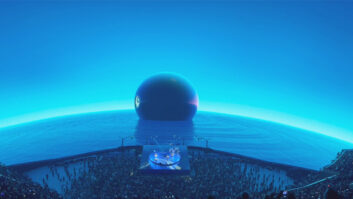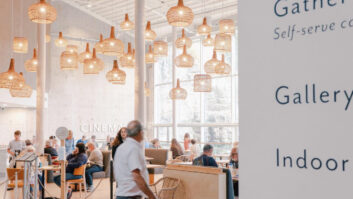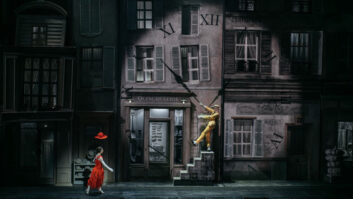
The Royal Albert Hall Auditorium was transformed into a cinema using the latest digital projection and audio systems to host the Spectre film premiere last month.
Sony Pictures Releasing (UK), the films distributors hired event specialists Andy Peat Associates to manage the project and Nibbs Events to produce the ‘Red Carpet’, press and VIP arrivals on the South Steps. The two companies also worked on Bond films Die Another Day and Skyfall, which also premiered at the Royal Albert Hall (RAH).
Technical director Andy Peat explained: “The films’ producers Michael G Wilson and Barbara Broccoli are very clear and precise in what they want so we all know exactly what’s expected of us.”
The screen was 20m wide by 8.9m high, a 2:39 ‘scope ratio. A high gain Perlux 140 perforated screen was commissioned and custom built by Harkness at their factory in France especially for the premiere. An air-conditioned booth in Grand Tier Boxes 21 / 22 and 23 was built to house the projection and playback systems. Primary projection was from a pair of Sony SRX-R320 projectors with a DoReMi IMB and Showvault to run the film in 4K.
“It’s not until you get into the realms of sound reproduction that things become a little trickier. Britannia Row Productions provided the audio infrastructure for us and there is history here. We’ve worked together on all the premieres I’ve done at the hall and all with the sadly missed Derrick Zieba. It was he and Britannia Row’s Bryan Grant that came up with the audio designs for the ideal 5:1 and 7:1 systems for this auditorium and refined them over the years. Bryan Grant suggested Colin Pink as the ideal man to fill Derrick’s shoes and so it proved; he and Richard Sharratt, who he brought in to engineer the system, did a really great job.”
Pink commented: “The first thing to say is staging this in the RAH and being in the round, presents its own set of problems, timing being the main one. So we spent a lot of time and attention setting that to retain clarity. The thing is the distances involved are so much greater than most typical cinemas.”
The fundamentals of the system were L-Acoustics K1 and K2 hung L/C/R upstage of the screen, with a large contingent of L-Acoustics coaxial MTD 108P for surround sound distributed throughout the auditorium.
“Of course the film is not recorded in 7:1,” continued Pink. “That sound track is created by, in this instance, sound director Scott Millan. He and the film’s sound editor Per Hallberg came down to the RAH mid-morning to check how we had the system setup and how it sounded. With my background in the theatre (Pink worked at the National for ten years) I always set up in rehearsal not to make it sound good, rather I try and anticipate what will happen with a full auditorium. Scott understood that absolutely. The first thing he did upon arrival was to say, ‘I just want to sit and acclimatise for 10 minutes’. Scott and Per were both very pleased, their only notes were to soften a bit of EQ on one part of the system, and reduce the level slightly in one element of the surround.”







